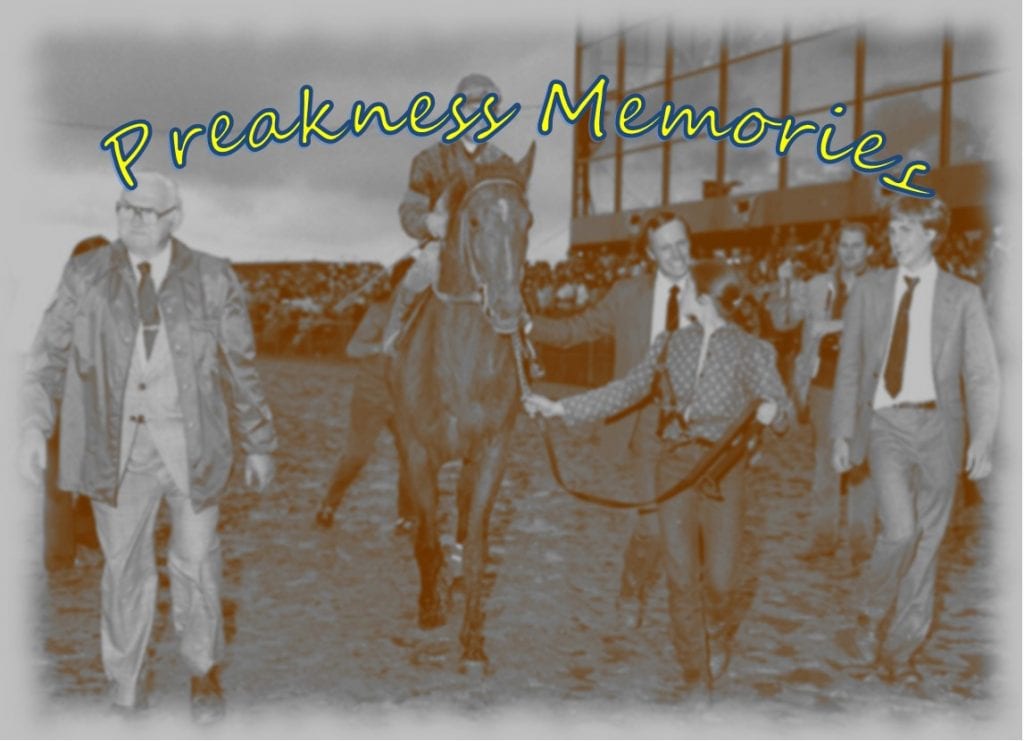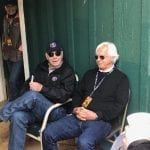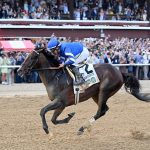PREAKNESS MEMORIES: THE CONTROVERSIAL CODEX

On February 28, 1977 a chestnut colt by Arts and Letters made his way into the world. Bred and owned by Tartan Farms, the colt was given the name Codex and was later placed in the training care of eventual Hall of Fame trainer D. Wayne Lukas.
Nobody could have guessed it at the time, but the colt would be destined to be adorned in the cape of Black-Eyed Susans come May of his three-year-old year – and to be one of the stars in perhaps the most controversial Middle Jewel of all.
Codex began his career at the age of two, finishing fifth in his debut at Hollywood Park. The second time proved to be the charm for the young colt, and Codex found himself in the winner’s circle after besting his rivals in a maiden special weight at the same track one month later. Codex raced five more times that season, claiming victory once more in an allowance race at Santa Anita Park.
Codex was off to a slow start at the turn of his three-year-old season. He kicked off his season in an allowance race at Santa Anita, where he finished third. That effort was followed by a troubled sixth-place finish and then a fourth before he finally returned to winning form in his fourth attempt that season, all in allowance company.
But then, it was as if the light switch finally went on for Codex, and there was no looking back. The colt had figured racing out.

After Codex’s allowance victory at Santa Anita, Lukas decided to take things up a notch in Codex’s next start. He entered his colt in the Grade 1 Santa Anita Derby, and it was a test that Codex passed with flying colors. After his score in his first graded stakes race, it was off to the Hollywood Derby (G1) at Hollywood Park, where Codex once again showed no mercy to the competition.
With the speed and strength of Codex now undeniable, Lukas was soon found kicking himself for failing to nominate the colt to the Kentucky Derby in time. “I almost fell over [when he found out his horse was not nominated to the Derby]. I was sick it was my first chance to run in the Classic,” Lukas recalled.
But as it was, he decided to set his sights on the next big prize that racing had to offer: the Preakness Stakes.
A crowd of 83,455 – then the largest in Preakness history — gathered at Pimlico Racecourse for the 1980 Preakness Stakes. Fans flocked to catch a glimpse of the Kentucky Derby winner, who appeared poised to rewrite history. Two weeks earlier it had been a filly who had captured not only the roses in the Kentucky Derby, but also the hearts of thousands. That filly was Genuine Risk, who outran both history and her 13-1 odds on the first Saturday in May to become the first female to win the Derby since 1915, and at the time, only the second overall (Winning Colors would become the third eight years later).
- Jorge Vargas notches 1,000th win
 Jockey Jorge Vargas, Jr. piloted Gran Yaco to a 13-1 upset in Monmouth’s Friday finale to earn the 1,000th win of his riding career.
Jockey Jorge Vargas, Jr. piloted Gran Yaco to a 13-1 upset in Monmouth’s Friday finale to earn the 1,000th win of his riding career.
At the time of the Preakness Stakes, Genuine Risk was a winner of seven races from eight starts and a very real threat to take the Triple Crown. Her thrilling victory over the boys in the Kentucky Derby set the filly up as a feel-good story that had people of all ages rooting for her. However, when the starting gates flew open in the Preakness Stakes, Codex and his rider Angel Cordero Jr. were prepared to have a say in the outcome of the filly’s story.
Codex, Genuine Risk, and the Preakness DQ that wasn’t
Codex flashed speed at the start of the race but was soon content to settle behind the two speed horses. Racing in third for much of the race, Codex was already clear of Genuine Risk, who raced toward the middle of the back. As the field neared the turn for home, Codex sprang into action with a powerful acceleration that propelled him to the lead. With rapid strides Codex maintained his advantage entering the far turn, but his mission wasn’t over yet. From behind him came the imposing white face of Genuine Risk, steadily gaining on the leader.
The crowd roared as Genuine Risk moved up to challenge Codex. As the pair raced around the turn, the Preakness Stakes appeared ready to become a two-horse race. Sensing the challenge from the Derby winner, Cordero made a move that would leave the 1980 Preakness Stakes in eternal controversy.
As Genuine Risk drew near, Cordero allowed Codex to drift wide into the stretch, forcing Genuine Risk to lose ground and go wide with them. During this move, Cordero appeared to make contact with the filly, bumping into her and cutting her momentum just as she appeared to be hitting her best stride. The confrontation caused the filly to falter, and Codex drew away to score by 4 ¾ lengths.
The Daily Racing Form chart of the 1980 Preakness Stakes described the scene as follows: “Cordero looked back entering the stretch, angled extremely wide, intimidating and lightly brushing Genuine Risk.”
Jacinto Vasquez, the rider of Genuine Risk, immediately claimed foul after the race. Vasquez claimed that Cordero had intentionally caused his mount to drift into his path, and that he had even hit Genuine Risk with his crop while whipping Codex. A long delay followed while the stewards mulled over their decision, but in the end, no change was made to the finish of the race, leaving much of the public in heated outrage.
- Edy’s Flame heats up in first CT 2yo race
 Edy’s Flame dominated Charles Town’s first 2yo race of the year, a somewhat surprising result even if bettors focused on the right connections.
Edy’s Flame dominated Charles Town’s first 2yo race of the year, a somewhat surprising result even if bettors focused on the right connections.
“Cordero mugged me and got away with it,” Vazquez later said in an interview with The Baltimore Sun. “He pushed my horse out into the parking lot. He undressed me, barbequed me and took me to the clubhouse.”
Following the race, Pimlico became bombarded with angry calls and letters of protest. Fans were furious that Cordero and Codex were not disqualified for what many considered to be a dirty win. Public outrage boiled to the point that Cordero began receiving angry letters and death threats that would go on to last for months. However, only two weeks after the race, the Maryland Racing Commission voted 3-1 to deny an appeal of the stewards’ decision to let the victory stand. In part, their decision turned on a series of photographs taken by Baltimore Sun photographer Weyman Swagger that showed no contact between the two runners.
Codex and Genuine Risk met again three weeks later in the Belmont Stakes. Neither horse claimed victory that day as underdog Temperance Hill pulled off a shocking win, but Genuine Risk did manage to get the best of the colt who ended her Triple Crown dreams. Genuine Risk finished a valiant second in the 1 ½ mile test, becoming the only filly in history to hit the board in all three of the Triple Crown races. Codex could do no better than seventh that day, in what would end up being the final race of his career.
After emerging from the Belmont Stakes sore, the decision was made for Codex to retire from the races. After a career of six wins from fifteen starts and earnings of $534,576, Codex was off to begin his new career as a stud at Tartan Farm. As a stallion, Codex went on to sire 71 individual winners and ten stakes winners.
Codex passed away on August 20, 1984. He was found paralyzed in his stall and as a result had to be humanely euthanized. While the stallion’s life may have been short lived, his story will forever live on through the history of his unforgettable run in the 1980 Preakness Stakes.
LATEST TRIPLE CROWN NEWS















